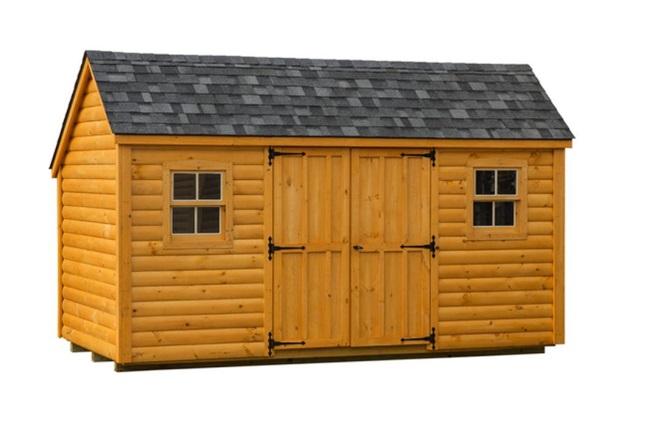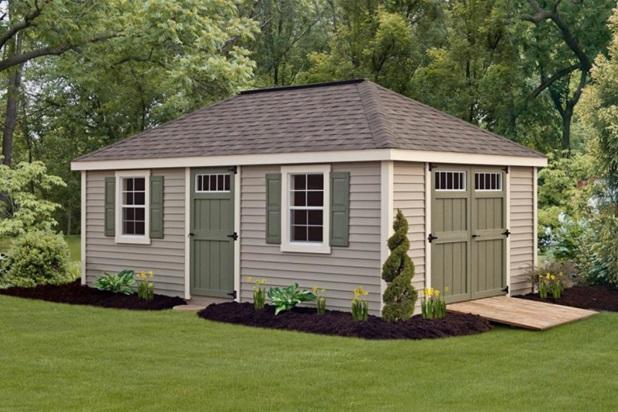When the winter season and cold weather approaches, homeowners find themselves putting away seasonal items they may not need again until spring or summer.
This could include larger items like outdoor furniture, riding mowers, and bikes or smaller items such as gardening supplies, sports equipment, or summer toys like splash pads and yard games.
For many, a shed is the ideal solution to store their items safely. But not all sheds are created equal – especially when it comes to withstanding harsh winter conditions.
Choosing the right shed type and right shed materials is important, and the team at Lancaster Barns can make sure you get a weather-resistant shed that will last for years to come.
In this post, we’ll explore the pros and cons of different durable shed materials. We’ll also share essential shed maintenance tips so your stored items stay safe and secure over the winter months.
Common Shed Materials
When it’s time to purchase a shed, there are many to choose from. You can pick from different styles, sizes, colors, and cold weather shed materials. And you may want to work with a shed manufacturer (like Lancaster Barns!) that allows you to customize your shed to your personal design taste and desired usage.
Some popular shed materials are wood, metal, or siding and each can have advantages and disadvantages. Learn more below and decide what type might be best for you.
Wood
Wood sheds have a traditional appeal that many homeowners like. They offer a timeless, natural look that can blend seamlessly with your property’s landscape. They also offer longevity that some other shed materials just can’t match.
Wood is an excellent insulator, so the interior of a wood shed will stay warmer during frigid temperatures. This is beneficial if you’re storing items that may be sensitive to cold temps.
On the flip side, wood sheds are susceptible to moisture brought on by snow and melting ice. This can lead to issues such as mold or warping. And to prevent rotting issues, keep your wood properly sealed by making sure your stain or paint is in good shape.
With proper maintenance, a rough-cut wood or log shed will remain strong, sturdy, and functional for years to come.

Metal
Metal sheds are durable and robust – able to withstand heavy snow and wind. Unlike wood, metal sheds are resistant to insects and rodents and don’t require as much maintenance as wood sheds.
One disadvantage of metal sheds is they have poor insulation and temperature control, making them very chilly throughout the winter months.
You can, however, insulate a metal shed to regulate the temperature. Learn more in our How to Winterize a Shed article.
Metal sheds from Lancaster Barns are constructed using high strength 29 gauge ribbed metal siding. Two popular shed options include our Metal A-Frame Storage Shed and our Metal Quaker Storage Shed.

Siding
Siding sheds can be constructed from a wide range of materials, most of which are very durable and resistant to extreme weather conditions. They also require less maintenance than other shed materials and can often be more affordable when compared to custom-built wood sheds.
Lancaster Barns offers several types of weather-resistant shed siding materials including vinyl, board and batten, stone veneer, and others. Talk to our team about how you plan to use your shed, and we’ll make sure you get a quality shed that can last through all the East Coast seasons!

Essential Tips for Maintaining a Weather-Resistant Shed
Already have a shed on your property? Follow these helpful tips so your shed is ready to withstand the winter and keep your belongings safe.
Check Your Shed for Cracks and Gaps
Thoroughly inspect your outdoor shed for any holes, cracks, or gaps in the structure. These can lead to drafts and moisture build-up and compromise the shed’s integrity. Be sure to inspect the walls, windows, doors, shed corners, and joints.
Check for a Leaky Roof
Make sure your roof is intact and free of leaks because a leaky roof can lead to significant damage in the winter. Repair any damaged shingles or flashing to prevent water ingress during snowfall or rain.
Remove Heavy Snow
When possible, remove heavy snow and ice buildup from the shed’s structure, especially the roof or front porch. Also try to clear vents, cupolas, weather vanes, and flower boxes of heavy ice or snow. This lowers the risk of shed damage caused by excess weight.
Check out more helpful tips for how to winterize a shed.
Design Your Dream Shed with Lancaster Barns
Working with a reputable shed expert will ensure that your new shed will be a reliable storage solution through the cold weather months! Schedule your free consultation with a Lancaster Barns designer today!


